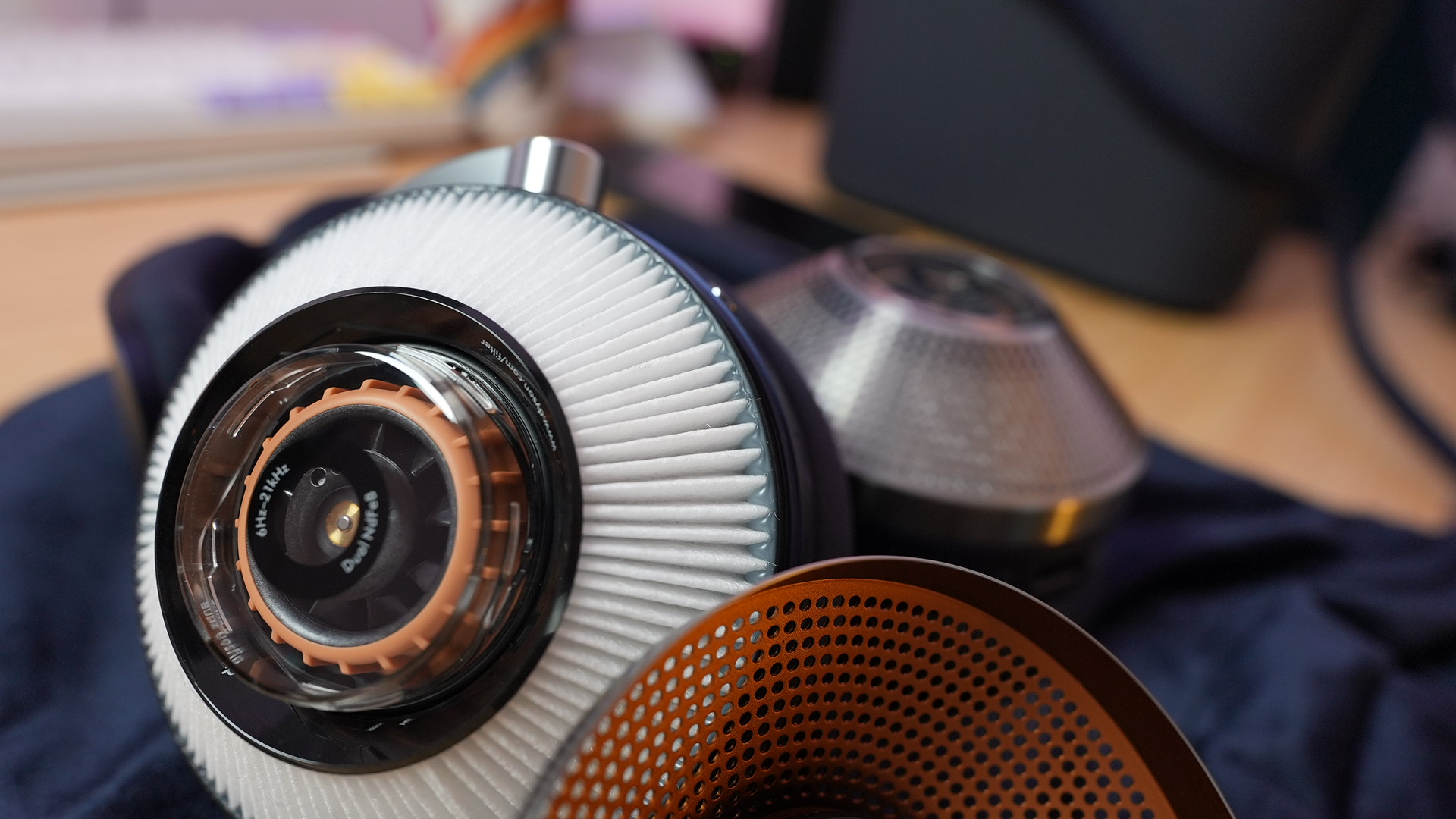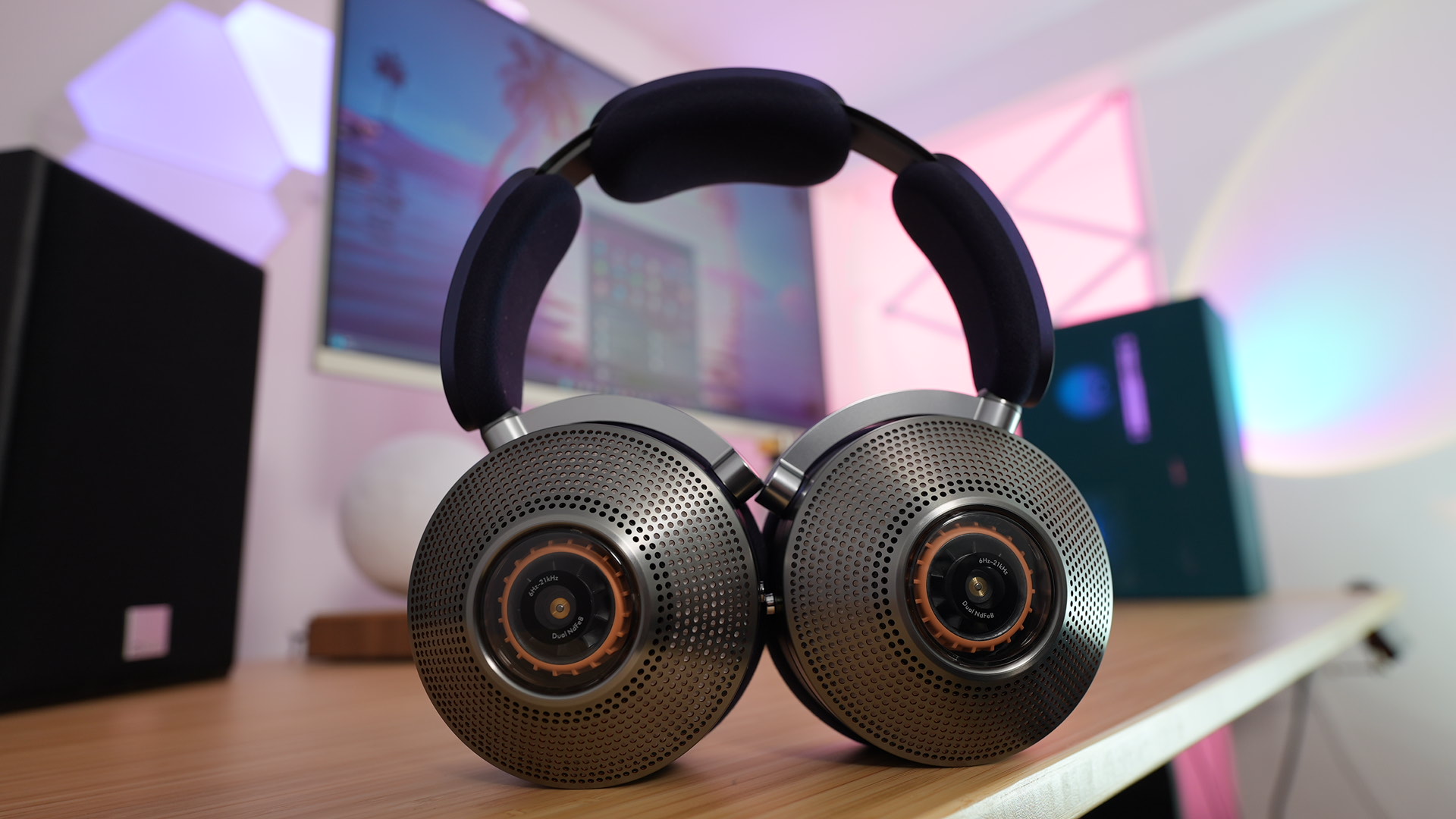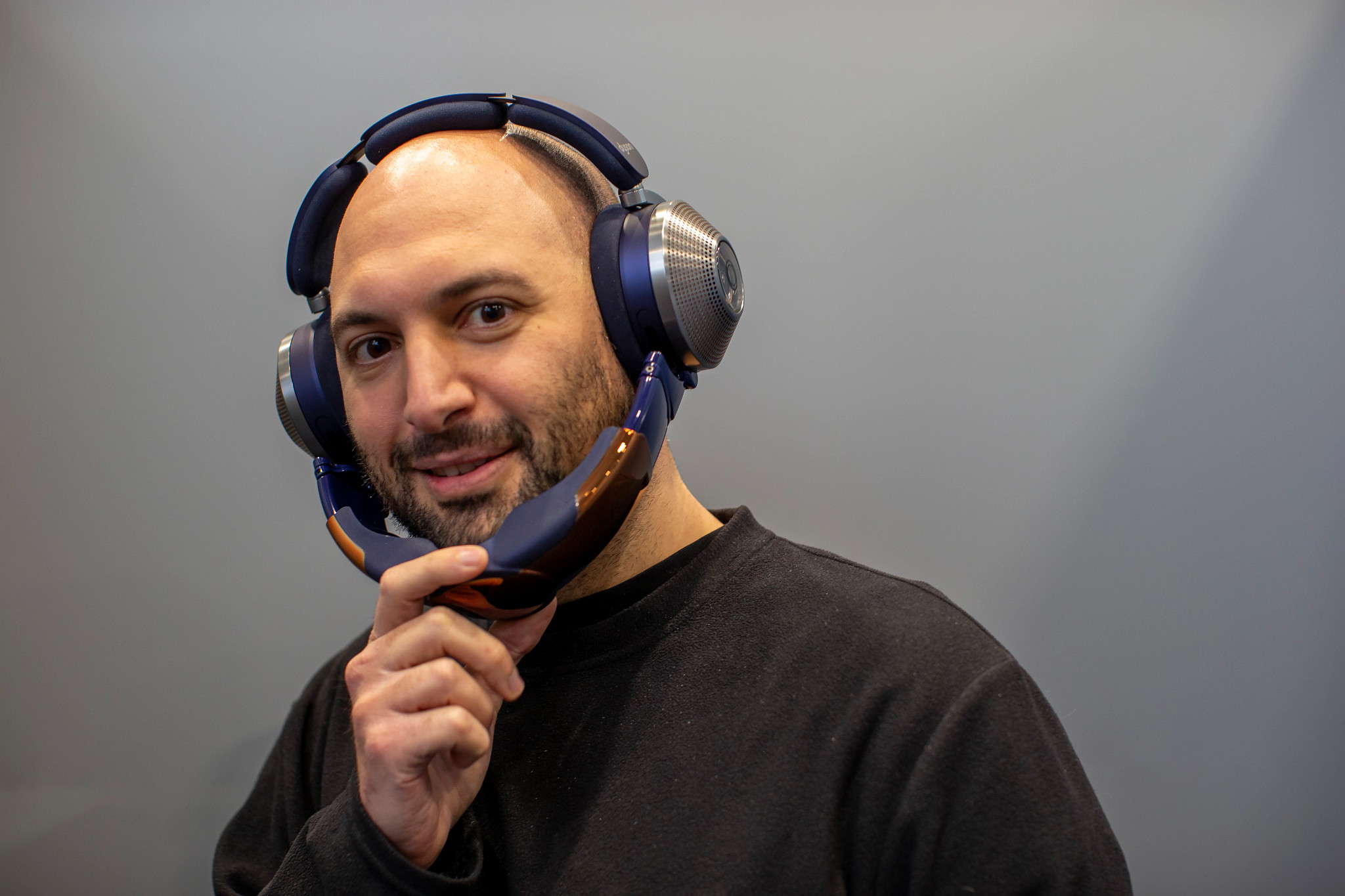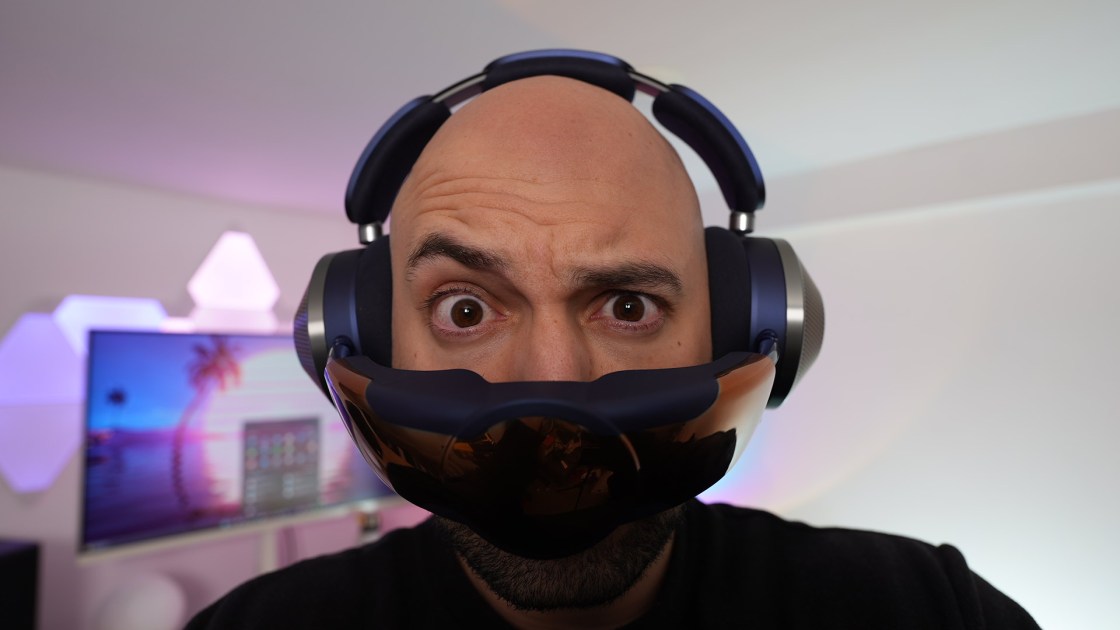Ten years ago, I found myself on a train to London. I was dressed as a ninja. It was Halloween. I’d gone all out.
Wrapped in traditional black Ninjitsu garb from head to toe (with foam nunchucks tucked into my unearned black belt for good measure), I was a rather unusual sight to behold as I disembarked at St Pancras to hop on the tube.
Being a naturally anxious person, this act required a fair amount of Dutch courage. Or Italian. I think it was sambuca. Either way, I was feeling far from fresh the next day.
The point of this inane rambling, is to create a hopefully captivating (if not SEO-destroying) segue into Dyson’s new Zone headphones – because I need an equal number of shots to have the confidence to wear them out in public.
I’ve been using them for a week, and still haven’t had the guts to step outside my front door with them – at least, not with the air filtration visor on.
That’s right. An air filtration visor.
If you missed the announcement last year (a day before April 1st, no less), here’s a recap: the Dyson Zone is a pair of headphones unlike any other. Each earcup houses a miniature compressor, which sucks in air and passes it through filters to purify it, before blasting it directly in front of your nose and mouth via a magnetically attachable visor.
It’s a bonkers concept. But that’s fine by me. Tech is getting boring, and anything that strives to be different deserves applause in my book. And hey, maybe you’re brimming with confidence and don’t care what other people think. If you’d happily rock the anime robot mech knight look next time you’re in Pret, then more power to you. I’m not here to judge. In fact, I’m jealous.
Starting at £749/£949 though, they’re far from cheap. And that’s without mentioning the pricier Absolute+ variant, which comes in a devilishly handsome dark blue and copper finish, with spare filters and velvet-lined carrying case (£829/$999).
For that money, you’d better be happy to visor up, otherwise there’s no shortage of great-sounding headphones for far less. But I digress. Here’s what I’ve made of the Dyson Zone headphones after a week of use. Enjoy.
Dyson Zone: Dressed to impress

The Zone’s design definitely stands out from the crowd. It looks and feels premium, and the earcups, littered with their precision-drilled air holes, resemble a high-end bit of kit from a fighter jet.
Naturally, given the air filtration tech within, they’re noticeably heavier than any other pair of cans you’re likely to try. This, coupled with the generously padded headband and super-soft earcups, lend it a luxurious feel that goes some way to justifying the incredibly high price tag.
Despite their weight, I find them very comfortable, and have worn them for a few hours at a time with no complaints. They do make my ears a bit hot after a while, mind, but that’s something I find with all over-ear headphones in general.
Dyson Zone: the great filter

Unscrew each earcup, and you’ll find a white, circular filter, that’s clearly a descendant of the ones used in the company’s formidable vacuums. An electrostatic/carbon affair, these filters are rated to catch all manner of pollutants and irritants, including dust, pollen, bacteria, ozone, and more. And while not waterproof, they’re IP51 rated, meaning that they should be able to shrug off a downpour with no problem.
Depending on where you live and the level of pollution they’re subjected to, you’re looking at replacing these around once a year. This will obviously vary, but the Dyson app will let you know when it’s time to change them out, which is handy, and the process is incredibly simple, taking just a few seconds per earcup.
And then of course, you’ve got the compressors, which are driven by impressively small-yet-powerful motors.
It’s a seemingly insane idea to rest something that spins a little under 10,000 rpm right on top of your ears – especially on a device that’s supposed to deliver a high-quality music listening experience. But Dyson’s engineers love a challenge, and having personally met some of them and seen the labs where they work their tinkering wizardry, they’ve tackled the problem with impressive results.
For starters, the Dyson Zone is crammed with microphones. These are used in the traditional active noise cancelling (ANC) sense of dulling annoying sounds like screeching tube brakes and plane engines, but they also power a specially tuned noise algorithm to help cancel out the worst of the compressor noise.
So can you hear them spinning? Sure. With the compressors working and no music playing, it sounds like a very distant neighbour doing some electric sawing in the background. That sounds like damning criticism, but it’s honestly not too bad. For one thing, it’s consistent, which means it easily fades into the background. And it’s dulled to the point where it sounds like you’re hearing them through very thick walls. In essence, at their quietest, you’re presented with a perfectly reasonable hum.

These are all pointless observations though, because you’ll be listening to music through these most of the time anyway. And when you do, you won’t really be able to hear the compressors at all. At least, not in any meaningful way that detracts from your experience.
There are three intensity modes: Rest, Light and Moderate – and an Auto setting which adjusts the compressor and motor intensity based on your breathing levels.
In Rest mode, I can’t hear the fans with music playing unless the volume is considerably less than half, which is much lower than I would ever listen to them.
Light mode sees the motors working a bit harder, and I’ve found that around half the max music volume is enough to drown them out.
Moderate sees the compressors working at max capacity, and they’re pretty loud with no music playing. I’ve found that I have to play music at a little under maximum volume before the compressors aren’t noticeable.
It’s worth pointing out that none of these modes have been an issue for me however, as I listen to music on or near max volume anyway. If anything, I feel that the Zone headphones could have a slightly louder max volume, though my ears could probably do without the extra strain. And in the interest of safety, you can actually keep tabs on both your volume levels and air quality levels in Dyson’s app.
As for the visor itself (and ignoring its aesthetics) it works well. Thankfully it doesn’t actually hug your face. Instead, it sits just in front of your nose and mouth, creating enough pressure for you to breathe in the clean air without any issues. It feels like a rather nice breeze, and is quite refreshing. In fact, I find myself missing the air when I’m not wearing them.
It’s easily attached with magnets that guide the whole thing together with a satisfying click. It’s hinged too, letting you lower it so that it rests under your chin like a cybernetic beard, in case you want to chat to someone or no longer need filtered air (it automatically stops the compressors when lowered).
Dyson Zone: music to my ears

When I tried an early prototype of the Dyson Zone headphones a few months ago, I wasn’t too impressed. They sounded a little muddy and flat, which is definitely not what you’d want in a pair of headphones at this price.
Thankfully I’m happy to report that Dyson’s sound engineers have clearly spent time refining things, as they now sound superb.
Sound is tight. Crisp. Close. A bit on the bassy side of the box for those that prefer a flat accurate sound like me, but only slightly. Pop the EQ to the Neutral preset though, and you’re golden.
There’s also an Enhanced and Bass Boost preset, with the latter providing an enjoyable (though thankfully not overpowering) low-end boost.
You can’t create custom EQ levels, given the tight control Dyson’s engineers have had to implement to counter the compressors, but I can’t see anyone but diehard audiophiles complaining with the superb audio experience offered by the three presets.
I’ve enjoyed their sound so much, in fact, that they’ve become my daily driver, handling everything from melodic trance to funky jazz with ease.
Dyson Zone: battery life

In pure headphone mode, you’ll get a respectable 50 hours of use per charge. That’s with noise cancellation switched on too, which is pretty impressive.
Throw in air purifying though, and this figure shoots down to a paltry four hours or so. Understandable, but still a shocking difference. Still, at least they’ll charge to 100% in three hours via USB-C.
Given that I’ve mostly been using them at home without much purifying action, I’ve got no complaints about battery life – but you’ll want to consider their longevity if you plan on long-haul flights with filtered air blasting in your face.
Dyson Zone: worth it?

At £749? For me personally? Absolutely not. Then again, I wouldn’t spend that much on any pair of headphones. I lose them. I break them. I have a cat and a toddler. I’m forever knocking over coffee mugs. It would be a very bad purchasing decision.
And, of course, I can get headphones that sound as good, if not better, for less. My default recommendation is still the (horribly-named) Sony WH-1000XM5. They’re £350. They sound great, have amazing noise cancellation, and tick practically all the boxes for most people. For substantially less than Dyson’s offering.
But you know what? While I personally lack the confidence to rock the Dyson Zone headphones out in public with the visor on, I applaud Dyson for innovating, and bringing us something new. And who knows, if there are enough brave people with pockets deep enough to give these a punt, they might catch on. Part of me hopes they do.
